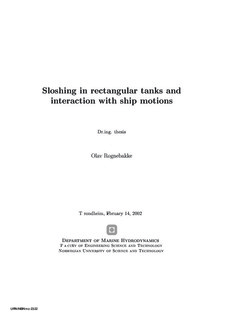| dc.contributor.author | Rognebakke, Olav | nb_NO |
| dc.date.accessioned | 2014-12-19T11:24:22Z | |
| dc.date.available | 2014-12-19T11:24:22Z | |
| dc.date.created | 2007-01-08 | nb_NO |
| dc.date.issued | 2002 | nb_NO |
| dc.identifier | 121580 | nb_NO |
| dc.identifier.isbn | 82-471-5408-0, h. | nb_NO |
| dc.identifier.uri | http://hdl.handle.net/11250/231128 | |
| dc.description.abstract | Sloshing is a violent resonent free surface flow in a container. The main objective of this thesis has been to study sloshing in rectangular and prismatic tanks. The tank may be excited by a harmonic motion or it may move with a ship in waves. In the latter case, the coupled ship motions and sloshing problem is investigated. A nonlinear analytically based sloshing model is used in the solshing calculations. Experiments have been conducedand collected data are utilized in the validation of the sloshing model and computations of interaction between sloshing and ship dynamics. Tank roof impacts are studied. Energy in the impact jet is dissipated and this leads to damping of the sloshing motion. An iterative procedure is applied to incorporate the effect of energy dissipation in the calculations. Damping of the soloshing motion is an important parameter around resonance for the coupled ship motion and sloshing system.
The sloshing model is based on a nonlinear theory analysis of two-dimensional nonlinear sloshing of an imcompressible fluid with irrotational flow in a rectangular tank. Infinite tank roof height and no overtuning waves are assumed. The free surface is expressed as a Fourier series and the velocity potential is expanded in terms of the linear natural modes of the fluid motion. The infinite-dimensional modal system is approximated and the result is a finite set of ordinary differential equations in time for generalized coordinates (Fourier cofficients) of the free surface. This theory is not valid for small water depth or when water impacts heavily on the tank roof. The proposed method has a high computational efficiency, facilitates simulations of a coupled vehicle-fluid system and has been extensively validated for forced motions.
Experiments with a smooth rectangular tank exited by forced harmonic horizontal oscillations have been performed and the results are used to validate the analytical sloshing model. Transients and associated nonlinear modulation of the waves, beating, are important due to the low level of damping of the fluid motion. The measured parameters are the motion of the tank and the free surface elevation at three positions. Pictures and video are used to study local flow details and the dynamics of the flow. At excitation periods in the vicinity of the first natural period for the fluid motion in the tank, even small motion amplitudes lead to violent sloshing and impacts between the rising water surface and the tank roof.
Impacts cause high pressures and forces. The effect of slamming in the tank is included by a local anlysis interacting with the nonlinear sloshing model. A Wagner based mthod is used to find the flow induced by slamming. Hydroelastic effects are ignored. The hypothesis that the kinetic and potential energy in the jet flow coused by the impact is dissipated when the jet flow hits the free surface, enables a rational calculation of the damping effect of impacts on the slishing flow. The Wagner approach requires a small angle between the impacting free surface and the tank roof. A correction by a similarity solution, or alternatively, by a generalization of Wagner's theory valid for larger angles is applied when this is not the case. Since anslytically based methods are used, fluid impact load predictions are robust.
A coupled ship motion and sloshing system is studied both experimentally and theoretically. Two-dimensional experiments on a box-shaped ship section excited by regular beam sea have been conducted. The section contains two tanks and can only move in sway. Fluid motion inside the tanks has a large effect on the sway motion response of the section. Simulatons of a corresponding system are performed by assuming a mainly linear external flow and applying the nonlinear sloshing model. The linear external hydrodynamic loads due to body motion are expressed in terms of a convoltion integral representing the history of the fluid motion. detailed numerical study of how to accuratly and numerical sway motion of the ship section is reported. The calculated cooupled motion is sensitive to the damping of the sloshing motion in a certain frequency range where the coupled sloshing and ship motions couse resonant ship motions. A quasi-linear frequency domain analysis is used to explain this by introducing the sloshing loads as a frequency dependent spring. | nb_NO |
| dc.language | eng | nb_NO |
| dc.publisher | Fakultet for ingeniørvitenskap og teknologi | nb_NO |
| dc.relation.ispartofseries | Doktoravhandlinger ved NTNU, 1503-8181; 16 | nb_NO |
| dc.subject | Væsker | no_NO |
| dc.subject | Hydrodynamikk | no_NO |
| dc.title | Sloshing in rectangular tanks and interaction with ship motions | nb_NO |
| dc.type | Doctoral thesis | nb_NO |
| dc.source.pagenumber | 171 s. | nb_NO |
| dc.contributor.department | Norges teknisk-naturvitenskapelige universitet, Fakultet for ingeniørvitenskap og teknologi | nb_NO |
| dc.contributor.department | Norges teknisk-naturvitenskapelige universitet, Fakultet for ingeniørvitenskap og teknologi, Institutt for marin teknikk | nb_NO |
| dc.description.degree | dr.ing. | nb_NO |
| dc.description.degree | dr.ing. | en_GB |

